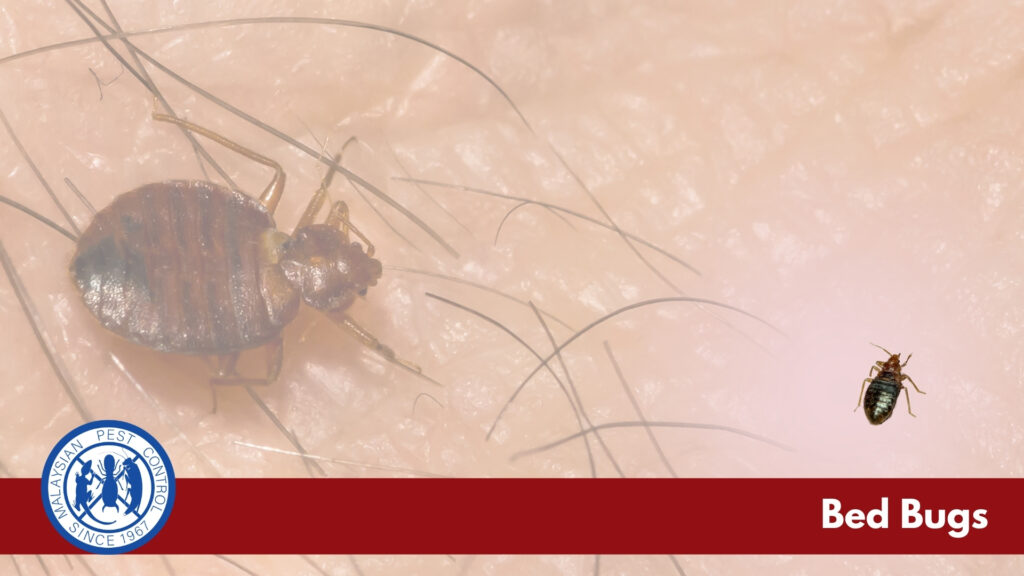About Bed Bugs

Introduction to Bed Bugs
- Bed Bugs are wingless insects with a reddish-brown color, measuring about 5-7 mm in length. They are known for their flat, oval-shaped bodies that swell and turn redder after feeding.
- Significance: They are considered a public health pest but are not known to transmit diseases. The primary concern with bed bug infestations is the discomfort from their bites, potential allergic reactions, and the challenge of eradication.
Biology and Lifecycle
- Egg Stage
- Female bed bugs lay white, oval eggs in hidden locations, such as cracks, crevices, and bedding.
- Timeframe: Eggs hatch in about 7-10 days, depending on environmental conditions.
- Nymph Stage
- Nymphs (juveniles) go through five molts before becoming adults, requiring a blood meal to progress to the next stage.
- Development: Each molting stage can last about a week, requiring a total of 5-8 weeks to reach adulthood.
- Timeframe: The entire development from egg to adult can take as little as 5 weeks in optimal conditions but often takes longer.
- Adult Stage
- Adults are capable of surviving months without feeding under cool conditions but will seek blood meals regularly if hosts are available.
- Lifespan: Adults can live about 10 months to a year in favorable conditions, with females laying hundreds of eggs over their lifetime.
Behaviour and Habitat
- Feeding Habits: Bed bugs are primarily active at night, feeding on human hosts without being noticed. They inject an anesthetic and an anticoagulant to ensure the host does not feel the bite.
- Habitat: They are adept at hiding in small spaces close to human sleeping areas, including mattresses, bed frames, furniture, and behind wallpaper.
- Dispersal: Bed bugs can spread from room to room or between apartments via luggage, furniture, and clothing.
Interaction with Humans and Pets
- Bites: Bed bug bites appear as red, itchy welts on the skin. Reactions to bites vary significantly among individuals, from mild irritation to severe allergic reactions.
- Psychological Impact: Infestations can lead to stress, anxiety, and sleep disturbances.
- Control Challenges: Their small size, nocturnal habits, and resistance to some pesticides make bed bugs difficult to control. Eradication often requires a combination of chemical treatments, heat treatment, and vigilant sanitation practices.
Why Bed Bugs are tough bugs?
Bed bugs (Cimex lectularius) are notoriously difficult to eradicate for several reasons related to their biology, behavior, and the environments they inhabit. Their resilience is further compounded by their developing resistance to various insecticides. Here’s a detailed explanation:
Biology and Behavior
- Small Size and Hiding Abilities: Bed bugs are small and flat, allowing them to squeeze into tiny cracks and crevices far from daylight, such as mattress seams, bed frames, behind wallpaper, and inside electrical outlets. This ability to hide in areas that are difficult to reach or inspect makes it challenging to eliminate them completely through cleaning or pesticide application alone.
- Feeding Habits: They can survive for months without feeding, waiting for a host to return or for conditions to improve. This means that even vacant rooms or furniture can harbor live bed bugs for a long time, leading to re-infestation.
- Reproduction Rate: Female bed bugs can lay hundreds of eggs over their lifetime, with each egg capable of developing into a bug that can continue the cycle of reproduction. Even a small number of surviving bed bugs can repopulate an area quickly.
Resistance to Pesticides
- Chemical Resistance: Over time, bed bugs have developed resistance to various insecticides, including some pyrethroids, which were once effective. This resistance is due to genetic mutations that protect them from the toxic effects of these chemicals. For instance, certain enzymes can break down insecticides before they can act, or changes in the bed bug’s nervous system can reduce a chemical’s effectiveness.
- Adaptation: The widespread use of insecticides has exerted evolutionary pressure on bed bug populations, selecting for individuals that can withstand chemical treatments. These resistant bugs survive and reproduce, passing on resistant traits to their offspring.
- Behavioral Resistance: There’s evidence to suggest that bed bugs can develop behaviors to avoid pesticide-treated areas, further complicating control efforts.



